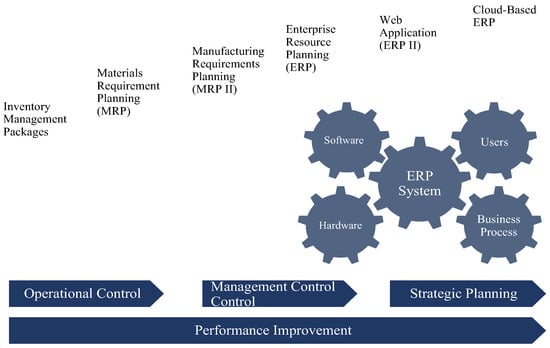The latest industrial revolution 4 enabled significant performance improvement through technological advancements. Simultaneously, the industry is setting high-level expectations for changing business practices toward long-term benefits in all three sustainability dimensions. The concept of sustainability embraces all production and operation processes in the Architecture, Engineering, and Construction (AEC) industry.
- sustainability
- BIM
- ERP
1. Introduction
2. ERP and Sustainable Performance
2.1. Enterprise of the Future

| Industry Characteristic | Literature Source |
|---|---|
| Fragmented | Çınar and Ozorhon [18]; Underwood et al. [21]; Tatari & Skibniewski [23]; Koeleman et al. [24] |
| Project-based and decentralized activity | Chung et al. [15]; Barreiros et al. [22]; Koeleman et al. [24] |
| Require specialized systems for specialized segments | Tambovcevs [12]; Sardroud [25] |
| Unstable and temporary structure | Hasabe & Hinge [20]; Tambovcevs [12]; Sardroud [25] |
| Geographically dispersed | Çınar and Ozorhon [18]; Underwood et al. [21]; Barreiros et al. [22] |
| Diversity of stakeholders with different levels of expertise and training | Barreiros et al. [22] |
| Highly heterogeneous sector | Mexas et al. [26] |
| Resistance or reluctance to change; | Çınar and Ozorhon [18] |
| Lack of investment in new technologies and different periods | Mêda et al. [16] |
| Transient nature of the process | Mêda et al. [16] Koeleman et al. [24] |
| Lack of replication | Koeleman et al. [24] |
2.2. Real-Time Management Systems
IT enterprise infrastructure comprises technical properties known as real-time data sharing [22], seamless integration, and information processing [23]. According to case studies analyses, Underwood et al. [19] mentioned that ERP solutions play a key role in information centralization. At the same time, a real-time picture facilitates decision-making and addresses routine tasks more efficiently, specifically in terms of project activities, the system controls planning, procurement, production, and logistics subsets [37].
In the context of the construction materials management module of ERP software, the main focus for evaluation. Obtaining up-to-date information on materials management is critical for project execution. That covers materials management, from ordering the right material to timing delivery [9]. For the production and manufacturing industry, materials management is a core module of ERP that provides real-time visibility on material characteristics and availability, having a crucial impact on operations. However, managing material on a construction site is still full of unanticipated challenges [9]. Any discrepancies lead to disruptions in a construction process, schedule fluctuations, cost overruns, and, therefore, delays in project delivery. The most common challenges include supply delays, outlying materials, incorrect storage locations, stolen materials, schedule shifts, gaps in project planning, manual paperwork, and others. The underlying reasons vary from country to country, from poor materials management systems to a lack of commitment. To overcome these obstacles, the supply chain, being an integral part of ERP, fully employs the latest smart technology to add value with the advancement of the fourth industrial revolution [41]. Therefore, ERP enables the automation and digitalization of the planning, scheduling, ordering, shipment, and storage functions, promoting sustainable supply chain management. Based on ERP data, construction practitioners evaluate performance measures to, in a timely manner, identify risks and develop relevant curbing strategies if required.
3. BIM’s Role in the Sustainability Trend
3.1. Sustainable Design
3.2. Building Performance and Facility Management
4. Sustainability via ERP and BIM Integration
-
better procurement coordination in ordering the right material and the quantity, raising the awareness of stakeholders about any missing items [81];
-
Improve the transparency of site activities, defining the project’s boundaries, which allows for a reflection of the financial consequences of any decision [3];
-
cost reduction for onsite activities by incorporating prefabrication and modularization, whereas cost optimization expanded to inventory-associated charges [84];
-
streamline sustainability from the design phase (BIM capacity) to business processes in the construction phase (ERP domain) [10];
-
provide a more user-friendly and efficient environment for stakeholders [85].
-
Integration standards shall be developed for the integration of ERP and BIM interrelated databases [11];
-
ERP and BIM are conceptually distinct functionality software, whereas ERP is dedicated to the management, not the technical aspect [81];
-
Compatibility issues due to different functional structures [10];
-
Difficulties with potential savings identification, since besides new system implementation cost, legacy systems integration becomes an obstacle [3].
This entry is adapted from the peer-reviewed paper 10.3390/buildings12101761
